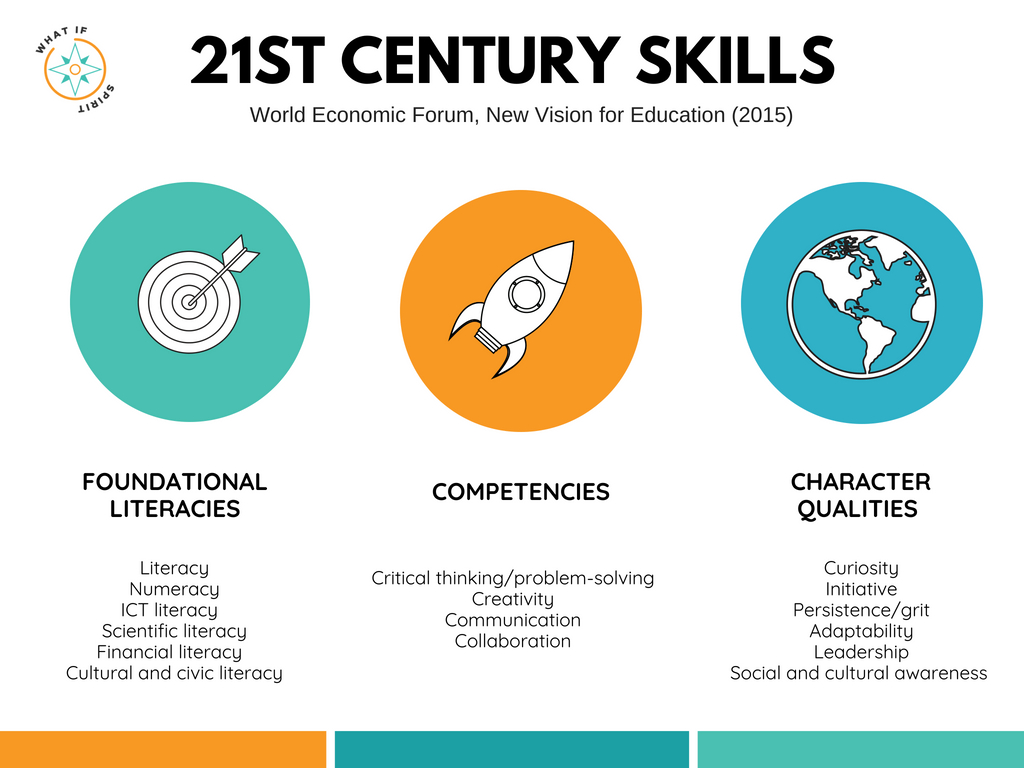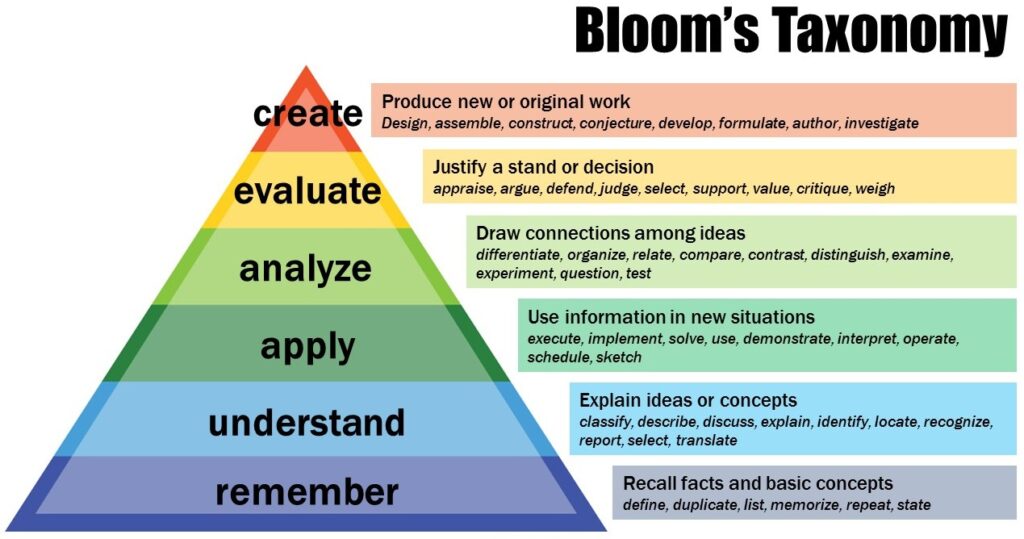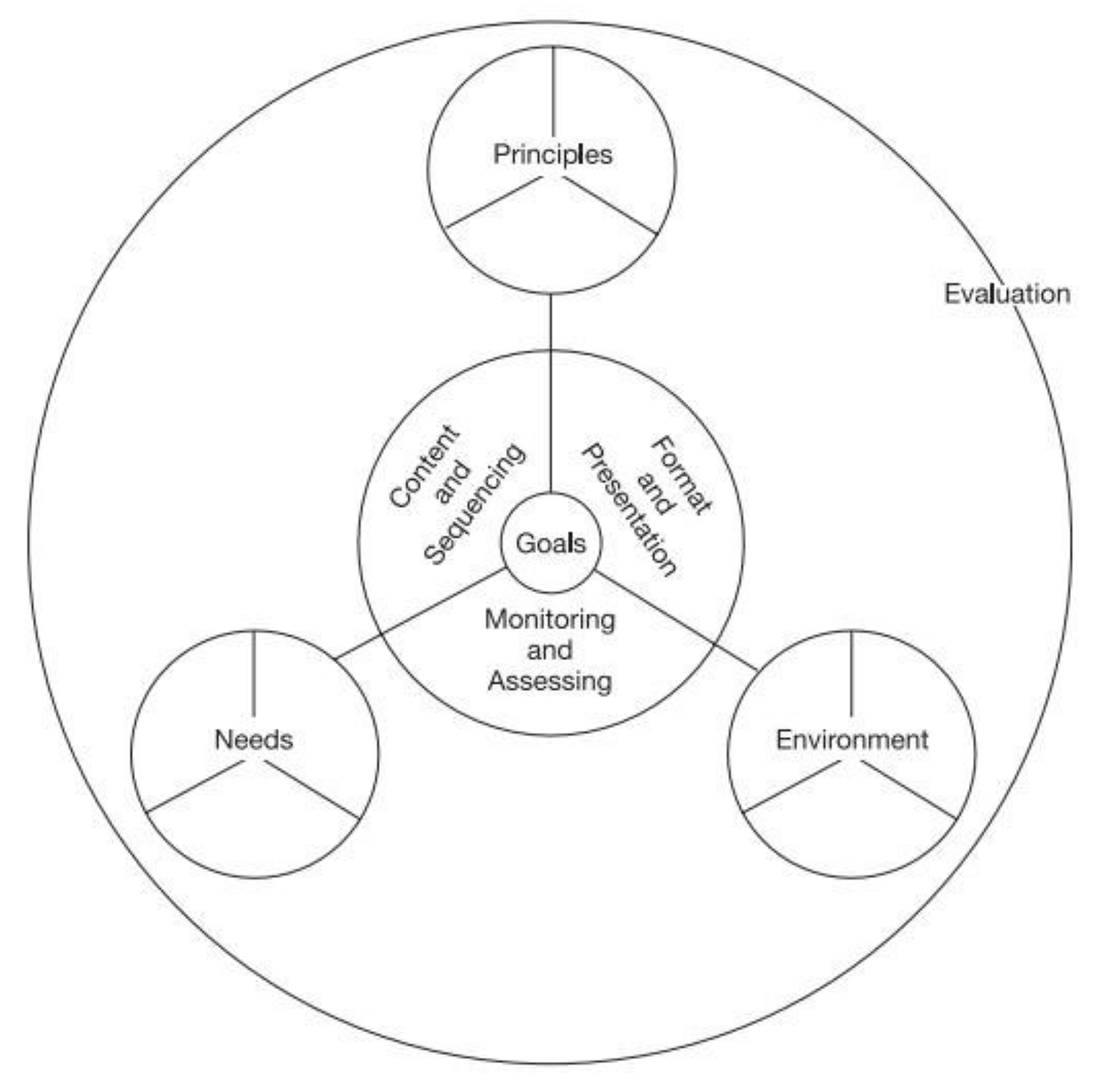Boosting Students’ Innovative Design and Computational Thinking Through Project-Based Learning in Higher Education

Higher Education emphasizes higher-order thinking (HOT) activities to equip students with 21st-century skills. Remarkably, incorporating technologies in various classroom activities is highly suggested in this disruptive era to enhance 21st-century skills. Notably, thinking skills and creativity in 21st-century education are essential in creating global competitive graduates (Yuyun, 2020). One of the learning activities in higher education applying HOT is project-based learning (PBL). I will share a PBL activity implemented in my classroom, designing an e-module for teaching English for specific purposes. Students must identify and solve problems in this project-based learning by conducting a course design sequence.

Figure 1. 21st Century Skills

Figure 2. The Revised Framework of Bloom’s Taxonomy
What are Innovative Design and Computational Thinking?
Leveraging technologies in the classroom will indeed support students to be innovative designers and computational thinkers. In higher education, students can use various technologies within a design process to identify and solve problems by creating new, practical, or imaginative solutions. Besides, students develop and employ strategies for understanding and solving problems to leverage the power of technological methods to develop and test solutions (ISTE, 2022). These points are stated in ISTE Standards for Students, particularly as an innovative designer (point 4) and computational thinker. As an innovative designer, students are expected to:
a. Know and use a deliberate design process for generating ideas, testing theories, creating innovative artifacts, or solving authentic problems
b. Select and use digital tools to plan and manage a design process that considers design constraints and calculated risks
c. Develop, test, and refine prototypes as part of a cyclical design process
d. Exhibit a tolerance for ambiguity, perseverance, and the capacity to work with open-ended problems.
As a computational thinkers, students are expected to:
a. Formulate problem definitions suited for technology-assisted methods such as data analysis, abstract models, and algorithmic thinking in exploring and finding solutions.
b. Collect data to identify relevant data sets, use digital tools to analyze them, and represent data in various ways to facilitate problem-solving and decision-making.
c. Break problems into parts, extract critical information and develop descriptive models to understand complex systems or facilitate problem-solving.
d. Understand how automation works and use algorithmic thinking to develop a sequence of steps to create and test automated solutions.
As cited in Shin et al. (2021), computational thinking (CT) is not only beneficial for computer scientists and software engineers but is beneficial for everyone trying to understand phenomena, solve complex problems, or analyze multiple possible outcomes to make an informed decision (Grover & Pea, 2017; Wing, 2006). CT based on the simulation modeling perspective centers on five aspects: (CT1) decomposing a problem such that it is computationally solvable, (CT2) creating computational artifacts through algorithmic thinking, (CT3) generating, organizing, and interpreting data, (CT4) testing and debugging, and (CT5) making iterative refinements.
Project-Based Learning in Higher Education
Project-based learning involves students experiencing and making sense of phenomena as they participate in various science practices with big science ideas through constructing tangible products in collaborative activities (Krajcik & Shin, in Shin et al., 2021). Fundamental learning principles of PBL include 1) active construction of tangible products, 2) using meaningful questions to engage with various practices and big ideas in compelling real-world contexts, 3) active collaboration, and 4) use of cognitive tools.
Therefore, Shin et al. (2021) propose PBL design features for computational thinking through modeling, as seen in the following parts:
- Focusing on learning goals to demonstrate mastery of science ideas and CT practice.
- Starting with a driving question grounded in CT that students find meaningful to sustain engagement and drive learning through CT.
- Exploring the driving question by participating in science practices that intersect with CT (e.g., asking questions, developing and using models, planning and carrying out investigation, analyzing and interpreting data, constructing an explanation, and designing a solution) so that students see the value of and transfer their learning to everyday situations.
- Creating a set of tangible CT products in collaborative sensemaking activities to address the driving question so that students construct their knowledge as active learners.
- Scaffolding with learning technologies (e.g., computational modeling tools, discourse tools) to help students participate in activities and engage in CT beyond their normal abilities.
Implementing PBL through Designing E-Module for English for Specific Purposes
Designing E-Module for English for Specific Purposes is an output product from the Curriculum and Technology Design (CTD) course, which is given to the 7th-semester students of the English Department. CTD is designed to develop students’ ability to understand how technology can be integrated into EFL innovative curriculum designs and design a technology-enabled instructional strategy to promote EFL teaching and learning. Exceptionally, students are equipped to develop the EFL curriculum using technology-based applications (Yuyun, 2017).
This E-Module Project is given in the second half of the semester after the students are equipped with some theoretical concepts of technology-enhanced language learning. The students work in pairs for seven weeks to do the project. To create this E-Module, the students must carry out some steps of the curriculum design project. The steps include environment analysis, needs analysis, principle consideration, goals, content and sequencing, format and presentation, monitoring and assessment, evaluation in English for Specific Purposes (ESP) (Nation & Macalister, 2010). These sequences are done collaboratively in groups.

Figure 3. A Model of the Parts of the Curriculum Design Process
(Nation & Macalister, 2010)
1. Environment Analysis
Environment analysis involves looking at the factors that will have a substantial effect on decisions about the goals of the course, what to include in the course, and how to teach and assess it. These factors can arise from the learners, the teachers, and the teaching and learning situation. This step gathers sufficient information from the learners, teachers, and the teaching and learning situation. Importantly, this step applies the CT3 covering generating, organizing, and interpreting data with lower-order thinking skills (remembering, understanding, applying, analyzing). These activities align with the ISTE Standards for Students, points 5a and 5b.
2. Needs Analysis
This part of the curriculum design process aims to discover what needs to be learned and what the learners want. This analysis covers necessities, lacks, and wants (Hutchinson & Waters,1987; Nation & Macalister, 2010). Necessities refer to what the learners have to know from the function effectively. Lacks refers to what the learner knows and does not know already. Wants refer to what the learners think they need. To gather information regarding the environment analysis and needs analysis, some surveys or questionnaires are made and distributed using survey applications such as SurveyMonkey (www.surveymonkey.com), Google Forms (www.googleforms.com), Typeform (www.typeform.com), Zoho Survey (www.zoho.com), SurveyGizmo (www.surveygizmo.com), and SurveyPlanet (https://surveyplanet.com/). In this step, students still apply the CT3 covering generating, organizing, and interpreting data with lower-order and higher-order thinking skills (remembering, understanding, applying, analyzing, evaluating).
3. Principle Consideration
Curriculum design must connect the research and the theory of language learning and the practice of designing lessons and courses. This step provides a reasonable basis to guide teaching and help design. These principles must be based on research and theory and must be general enough to allow variety and flexibility in their application to suit the wide range of conditions in which language is taught (Nation & Macalister, 2010). Some applications can summarize and synthesize the related theories and principles from Canva (https://www.canva.com/), Mendeley (https://www.mendeley.com/), Endnote, and Nvivo. In this stage, thinking skill is sharpened as teachers are expected to summarize, integrate, and synthesize the related references. These activities are in line with the creative problem-solving strategy proposed by Kuo et al. (2014), which provides step-by-step guidance or scaffolding to help students identify the core of the target problem via knowledge sharing, peer interactions, conflict resolution, and information summarization.
4. Goals, Content, and Sequencing
This part of the curriculum design process aims to list the items to teach in the order they will be taught. The content and sequencing must take account of the environment, the learner’s needs, and the principles of teaching and learning. The curriculum design model in Figure 3 shows goals as the center (Nation & Macalister, 2010) since it is essential to decide why a course is being taught and what the learners need to get from it. Moreover, the content of language courses consists of the language items, ideas, skills, and strategies that meet the goals of the course. One way to provide a systematic and well-researched basis for a course is to use frequency lists and other language items or skills lists. Students apply higher-order thinking (analyzing, evaluating, and creating) in these steps. Also, students practice being innovative designers since they know and use a deliberate design process to generate ideas, test theories, creating innovative artifacts, or solve authentic problems (ISTE Standards for Students, point 4a).
5. Format and Presentation
This part of the curriculum design process aims to choose the teaching and learning techniques and design the lesson plans. The presentation of material in a course involves using suitable teaching techniques and procedures. There are three (3) advantages of having a set format for the lesson: the lessons are easier to make, the course is easier to monitor, and the lessons are easier to learn. To prepare a lesson plan, the teacher can explore the following applications www.lessonwriter.com, https://www.planbook.com/, https://www.chalk.com/planboard/, and https://www.planbookedu.com/. The plan book is also available on mobile in the android store.
Moreover, to select various activities types and learn the material used in the teaching and learning process, the following applications can explore http://edu.glogster.com/, https://learningapps.org/, https://popplet.com/, http://www.breakingnewsenglish.com/, https://lyricstraining.com/, http://www.movieclips.com/, and http://www.tagxedo.com/. The teachers can create an interactive book or module using the following applications such as https://pressbooks.com/, www.pubhtml5.com, www.fliphtml5.com, www.anyflip.com, www.flipsnack.com. Again, in these steps, students apply more higher-order thinking (analyzing, evaluating, and creating) and the ISTE Standards for Students, points 5b, 5c and 5d.
6. Monitoring and Assessment
This part of the curriculum design process aims to decide what to test and how to test it. The outer circles of the curriculum design model (environment, needs, and principles) provide data to guide the planning of the processes in the inner circle. Thus, monitoring and assessment must consider the environment, the learner’s needs, and the principles of teaching and learning. The significant types of monitoring and assessment are proficiency test, achievement test, placement test, diagnostic test, observation of learning, and short-term achievement assessment (Nation & Macalister, 2010). Some applications such as https://www.quibblo.com/, http://quizstar.4teachers.org/, https://kahoot.it/, https://quizlet.com/, and https://www.classmarker.com/ can be good resources to deal with any assessment tasks such as quizzes and scoring.
In these steps, students apply the CT4 covering testing and debugging as well as higher-order thinking skills (evaluating and creating).
7. Evaluation
This part of the curriculum design process aims to determine whether the course is thriving and needs improvement. The evaluation requires looking both at the course results, the planning, and the running of the course. It involves the amount of learning, quality of learning, quality of teaching, quality of curriculum design, quality of course administration, quality of support services (library, language lab, etc.), teacher satisfaction, learner satisfaction, sponsor satisfaction, later success of graduates of the course, and financial profitability of the course (Nation & Macalister, 2010). Again, in these steps, students apply the CT4 covering testing and debugging as well as higher-order thinking skills (evaluating and creating).
This E-Module Project can develop both thinking skills and creativity to create global competitive graduates. Ultimately, various activities in technology-enhanced language learning should be developed to sharpen other global skills in 21st-century education.
(Yuyun, 2020)
References:
ISTE. (2022). ISTE Standards: Students. https://www.iste.org/standards/iste-standards-for-students
Kuo, F. R., Chen, N. S., & Hwang, G. J. (2014). A creative thinking approach to enhancing university students’ web-based problem-solving performance. Computers and Education, 72, 220–230. https://doi.org/10.1016/j.compedu.2013.11.005
Nation, I. S. P., & Macalister, J. (2010). Language Curriculum Design. New York:
Routledge. Retrieved from https://www.slideshare.net/titiksastrosoewarjo/languagecurriculumdesign?from_action=sav
Shin, N., Bowers, J., Krajcik, J., & Damelin, D. (2021). Promoting computational thinking through project-based learning. Disciplinary and Interdisciplinary Science Education Research, 3(1). https://doi.org/10.1186/s43031-021-00033-y
Yuyun, I. (2017). Curriculum and Technology Design: A Course to Explore Technology Applications in EFL Curriculum Design. Journal of ELT Research, 2(1), 78–86. https://doi.org/10.22236/JER
Yuyun, I. (2020). Developing Undergraduate Students’ Higher Thinking Skills and Creativity through E-Module Project. ITELL (Indonesia Technology Enhanced Language Learning), 105–111.

Nina Vizcarrondo
Ignasia,
I will be bookmarking this post because it is SO useful. I am also interested in higher education and problem-based learning. I like that you approached it very thoroughly and clearly laid out examples. I especially liked that in each approach you used what apps would be beneficial for it. Thank you for sharing!
Melissa Dunworth
I like that you have given us all the steps that the students must follow as they work through designing their e-module. I can envision using something like this with my middle school students. Thank you for sharing!
Chelly Rody
Ignas, thanks for sharing a great example of project-based learning at the university level. I like how you laid out each step clearly. I am positive it was such an engaging project for the students. Thanks for sharing!